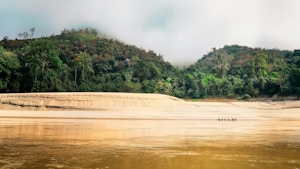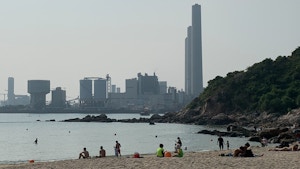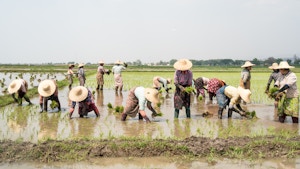Forty-four-year-old Sarjum has spent a large portion of his life relying on the waters along seaside Kanci for his livelihood, as his father – also a fisherman and salt farmer – had before him.
Growing up, Sarjum often accompanied his father to fish in the sea. In the summer months, he would fetch buckets from Mundu Bay to farm salt. Now, he looks out to the coastline dejected, spotting a towering coal-fired smokestack from the small home he shares with his wife and three young children.
For more than ten years now, a handful of quiet coastal villages in West Java, Indonesia have had their lives upended by the operations of a coal-fired facility that has polluted and encroached on their farmland and fishing grounds.
Operated by PT Cirebon Electric Power, the Cirebon 1 coal power project is a 204-hectare facility that sits along Mundu Bay and overlooks the Java Sea in the port city of Cirebon, some 220 kilometres from Jakarta.
The US$850-million facility has faced scrutiny from local stakeholders since its construction began in 2008, with allegations of corruption, harassment and human rights violations, on top of accusations of gross negligence that have brought about widespread environmental destruction after its operations began in 2012.

A local fisherman sits in front of their coastal community’s docked motorised boats with Cirebon 1 behind him. Image: ResponsiBank Indonesia
WALHI, or Friends of the Earth Indonesia, has documented that about 3,000 farmers and fisherfolk in the village of Kanci and some five neighbouring coastal towns have had their livelihoods disrupted by the power station.
Among them are Sarjum and his community.
“Life has become difficult,” Sarjum told Eco-Business in his native Bahasa Indonesia. “In the past, I could rely on fishing and salt farming to provide for my children. Now our family income has been more than halved and the salt ponds we used to farm are gone to give way to the power plants.”
Sarjum has taken to daily wage work to continue putting food on his family’s plate, earning just between 50,000 to 90,000 rupiah daily – or equivalent to US$6 to US$9 – for work as a labourer or welder. He shares that there are even days when there are no odd jobs available for him to earn a living.
“
It is grossly unfair that [policies like] the ETM incentivise large companies but exclude the community from the conversation. Compensation goes to the [conglomerates]. How about accountability to the people directly affected by the operation of these coal plants?
Dwi Sawung Rukmono, energy and urban campaign manager, WALHI
Through class action and protests, communities living between the Cipaluh and Kanci rivers, where the coal plant is located, have repeatedly raised their concerns about the devastating impacts of the project on their livelihoods and health.
“Every day, we are subject to black dust from the power plant,” related Sarjum. “Most in our community now suffer from lung diseases and respiratory problems, including me. Our rivers and sea waters have become murky and hot, the fish scarce. Even eating shellfish we harvest from the bay can cause food poisoning.”
According to research by Harvard University and Greenpeace Southeast Asia, existing coal plants in Indonesia cause an estimated 7,100 premature deaths every year.
Cirebon 1 is operated by Cirebon Electric Power (CEP), an international consortium made up of Japan’s Marubeni Corporation, South Korea’s Korean Midland Power Company and Samtan Company, along with the Indonesian power company PT Indika Energy.
It is funded by several international financial institutions, including Japan’s Bank of International Cooperation, Sumitomo Mitsui Banking Corporation, Mizuho Financial Group and MUFG Bank, as well as the Export-Import Bank of Korea and ING Group.
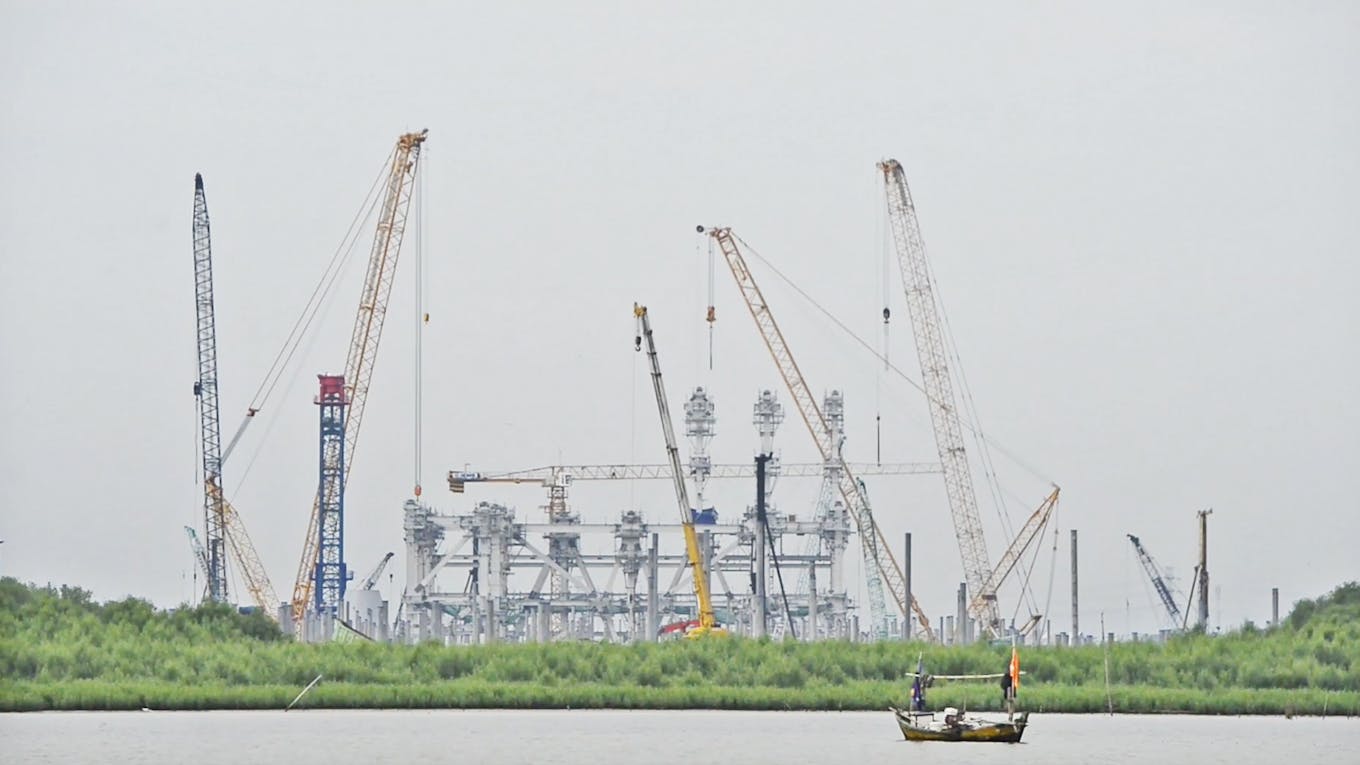
Construction on Cirebon 2 dwarfs a fisherman’s boat along Mundu Bay. Image: ResponsiBank Indonesia
“[Cirebon 1 investors] are partly responsible for the emission of toxic substances into the environment, damage to farmers and fishermen, and deaths from air pollution,” said Ah Maftuchan, coordinator of ResponsiBank Indonesia, a civil society coalition that champions the role of financial institutions in sustainable development. “Let ING Group [and other investors] take seriously and counter the concerns of local Indonesians about corruption and human rights violations by new coal-fired power stations in Indonesia.”
The story of Cirebon highlights how a just energy transition is a complicated process that involves navigating the economic interests of powerful corporations while balancing the need for justice for affected local communities. It is also a valuable case study that illustrates the real-world obstacles in Indonesia’s coal phase-out plan.
However, some positive developments appear to be on the horizon. In early November 2022, the operator of Cirebon 1 signed a deal with the Asian Development Bank (ADB) and Indonesian Investment Authority to potentially decommission the facility some fifteen years ahead of its operational lifespan. This should be seen as a welcome development for the local community, but the reality is more complex on the ground.
For one, there is a new coal plant called Cirebon 2 in the works—developed by PT Cirebon Energi Prasarana, a subsidiary of the same parent company as Cirebon 1—which may soon be operational.
There is also a dearth of accountability and reparations for the devastated fishing and farming communities from the operators of the facility. This has caused groups like ResponsiBank Indonesia and WALHI to call for CEP and its shareholders to be held accountable for the damage Cirebon 1 has caused the surrounding environment and local communities.
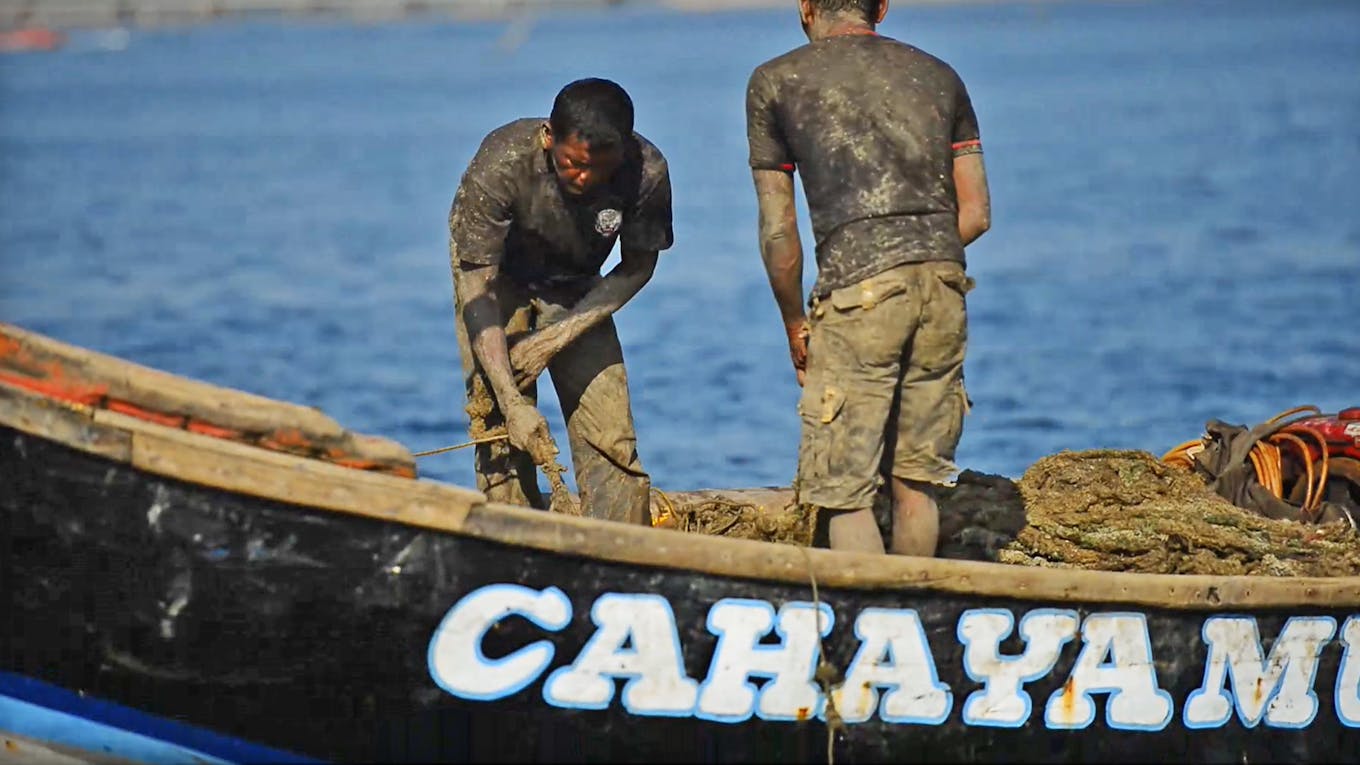
Kanci fishermen return muddied after harvesting shellfish due to heavy siltation along Mundu Bay. Image: ResponsiBank Indonesia
‘Flawed’ energy transition
The G20 summit in Bali in November 2022 concluded with a seemingly twofold win for Indonesia’s transition to clean energy: the unveiling of the pioneer Just Energy Transition Partnership (JETP) agreement in Southeast Asia, coupled with the announcement of the Asian Development Bank (ADB)’s Energy Transition Mechanism (ETM) support for the early retirement of private coal plants in the country.
The JETP agreement is set to allot some US$20 billion to catalyse Indonesia’s goal of doubling its renewable energy sources in the next three to five years to 34 per cent of its stock.
Meanwhile, the landmark ETM deal is ADB’s market-oriented solution to accelerate the process of taking coal power off of national energy grids in specific Southeast, South and Central Asian countries and replacing it with other sources of power. The initial agreement in Indonesia aims to terminate the operations of Cirebon 1 by 2037 at the latest, by expending US$250 to US$300 million in loans to refinance the facility.
However, with some civil societies, communities, and workers’ organisations flagging gaps in these “coal-to-clean” schemes, it remains to be seen if the new policies will produce any meaningful change for communities already impacted by widespread negative consequences wrought by coal plants in Indonesia, such as air pollution from fly ash and heavy metals contaminating bodies of water. Fly ash is a fine powder that is a byproduct of burning pulverized coal in electric generation power plants.
A report released on January 26, 2023, titled, The Asian Development Bank’s Energy Transition Mechanism: Emerging Social, Environmental and Rights-Based Considerations, jointly published by Fair Finance Asia (FFA) and NGO Forum on ADB (the Forum), highlights critical questions and concerns about ADB’s ETM.
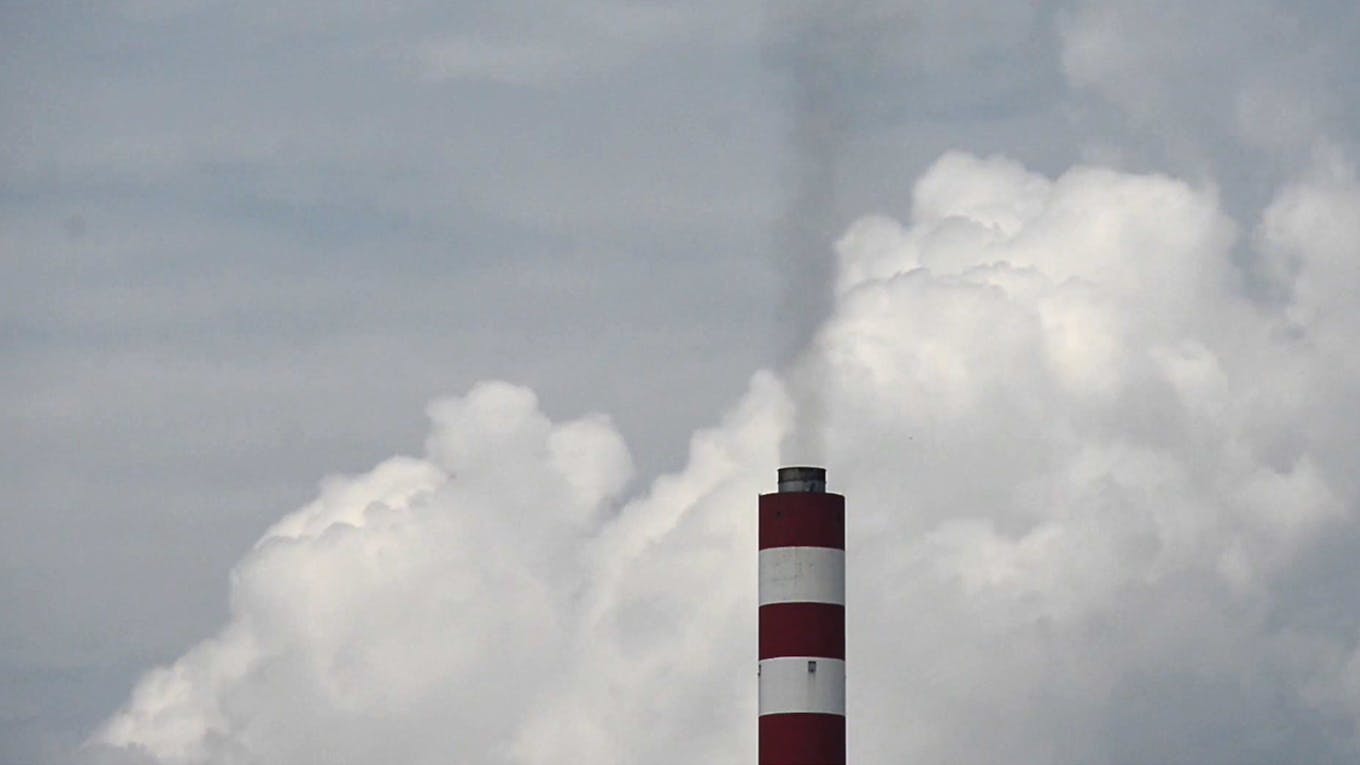
Smoke billows from the smokestack of Cirebon 1. The facility requires at least 2.3 million tonnes of coal supply a year to operate. Image: ResponsiBank Indonesia
FFA and the Forum’s report underscores that a genuine and just energy transition can only be achieved if operators and investors “meaningfully acknowledge [the] social and environmental damage” caused by facilities like Cirebon 1 while providing the appropriate compensation to communities where coal power projects were financed in the past and will now need to retire.
Energy Transition Mechanism
Manila-based Asian Development Bank’s (ADB) Energy Transition Mechanism (ETM) agreement was launched with Indonesia, while similar policies are in the pipeline for Kazakhstan, Pakistan, the Philippines, and Vietnam.
With the ETM partnership, ADB hopes to catalyse Indonesia’s phase-out of coal projects by providing between US$250 to US$300 million in private sector loans to refinance the 660-megawatt Cirebon 1 power plant in West Java, on the condition that the facility will be decommissioned 10 to 15 years before the end of their 40 to 50-year lifespan.
The report underlines that the ETM does not explicitly assure that the ADB’s environmental and social safeguard standards will be put in place for the welfare of the community ahead of the early retirement of Cirebon 1.
In relation to the proposed phase-out of the coal-fired facility, the report poses the question: “Will the surrounding communities as well as affected workers have the possibility to file grievances under the ADB’s Accountability Mechanism? It remains to be seen,” FFA and the Forum concluded.
The report further recommends that coal transition initiatives like the ETM should support a swift phase-out of coal by 2040 at the latest, while ensuring that fossil fuel-dependent infrastructure and associated facilities stay out of the energy investment pipeline in the near future.
“Civil society groups in the region are becoming increasingly concerned that the ETM is flawed by design,” said Rayyan Hassan, executive director, NGO Forum on ADB. “[It] seemingly [leaves] communities and workers at the very sites where the ETM will be proposed to be piloted, in the dark…while turning a blind eye to the demands by broad social movements across the region for publicly accountable processes to phase out coal and other fossil fuel industries without delay.”

Salt farms and agricultural land give way for the construction of Cirebon 2. Image: ResponsiBank Indonesia
Indonesia’s bet on ‘dirty’ coal
A 2021 study by Universitas Pendidikan Indonesia concluded that Cirebon 1 has caused significant “negative effects” on the water quality along Mundu Bay, an inlet connecting Cirebon’s rivers to the Java Sea.
The study found that coal debris and combustion dust have leached into the body of water through runoffs, affecting the viability of these waters to support marine life, and that the surrounding water could be contaminated with heavy metals that can cause health problems in the coastal communities in the near future.
Anecdotal information gathered by WALHI from a local health centre claims that there has been a major rise in severe chronic respiratory illnesses in the community due to fly ash from Cirebon 1. Aside from the loss of coastal fisheries, the plant has severely damaged Kanci’s traditional salt farms and rice fields due to air and thermal pollution, as well as runoffs tainting the soil.
Amidst ongoing opposition to Cirebon 1 from civil society groups and communities, in 2017, construction began on Cirebon 2, a US$2-billion expansion project adjacent to the first facility. The new plant, set to add 1,000 MW in power generation to the power station, was expected to be operational by 2022, but faced delays due to the Covid-19 pandemic.
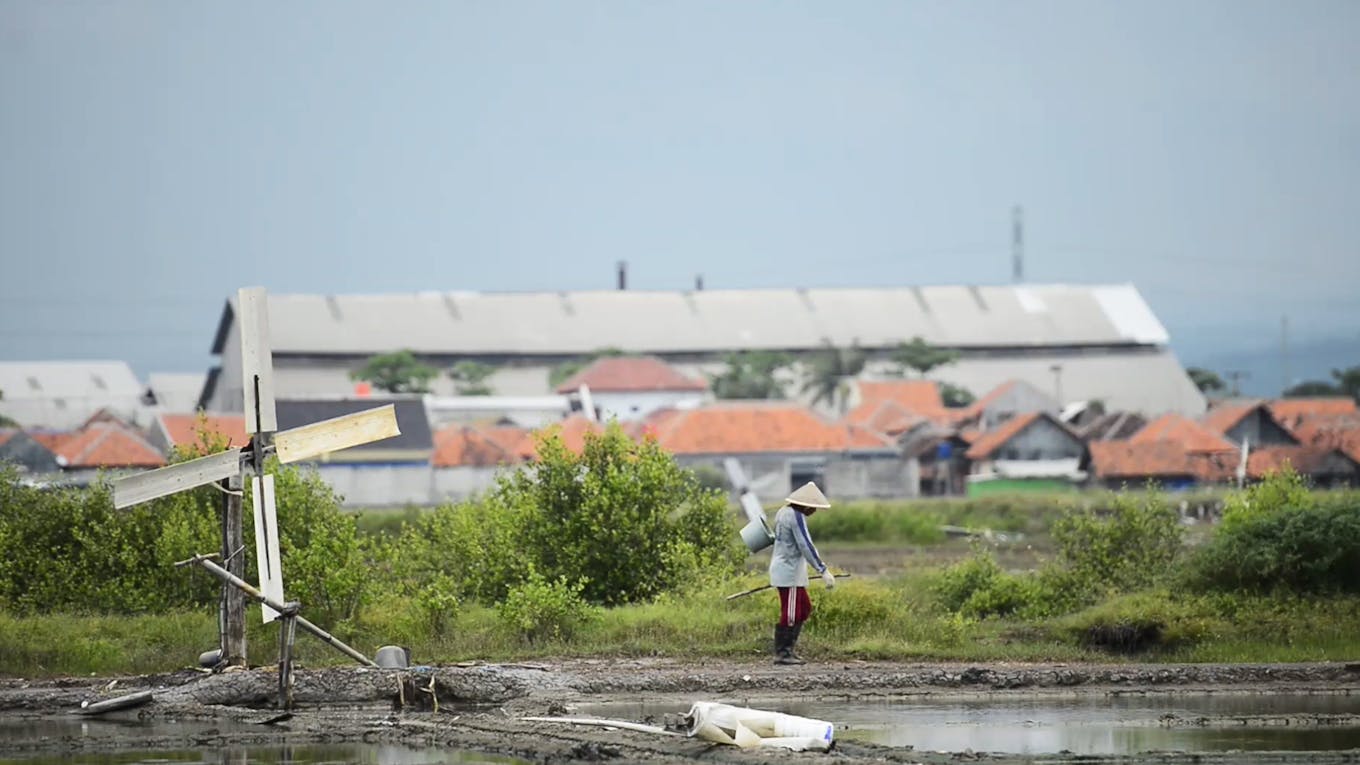
A local farmer tends to their land near Cirebon 1. Image: ResponsiBank Indonesia
Despite the US$20-billion JETP deal, Indonesia still has 19 GW of new coal capacity under construction and 7 GW in planning stages, according to data compiled by Global Energy Monitor. Among these is the coal-fired Cirebon 2 expansion in West Java.
Just Energy Transition Partnership
After South Africa, Indonesia is only the second in the world to launch its own Just Energy Transition Partnership (JETP) in cooperation with the International Partners Group (IPG), co-led by Japan and the United States of America, as well as by Canada, France, Germany, the United Kingdom and the European Union.
The JETP will mobilise some US$20 billion in the next three to five years to aid and accelerate Indonesia’s pivot to more renewable energy sources. The countries party to IPG are set to contribute US$10 billion to the JETP, while the other US$10 billion will be facilitated by the Glasgow Financial Alliance for Net Zero (GFANZ) working group.
Indonesia was one of the top 10 global polluters in 2019, producing almost 615 million tons of CO2, according to the World Meteorological Organisation, with 60 per cent of its energy resources dependent on coal. Its greenhouse gases have largely been attributed to the archipelagic nation’s heavy reliance on fossil fuels, as well as to fires and deforestation linked to the country’s oil palm industry – which has cleared large swathes of peatlands and woodlands to make way for plantations.
Leading up to COP27, Indonesia made a commitment to reduce its carbon emissions by up to 43 per cent by 2030 with cooperation from other countries. But the nation’s prolonged involvement in the coal business could make the switch to sustainable energy more difficult. Indonesia is the world’s largest exporter of thermal coal, earning at least US$3 billion a month from the extractive industry by delivering coal to China, India, Japan and South Korea, among others.
The International Renewable Energy Agency estimates that in order for Indonesia to raise its stock on renewable energy from just 14 per cent, it will have to fund some US$332 billion in energy transition technologies and US$80 billion in grid infrastructure development by 2030.

The US$850-million 660 MW coal-fired facility has received criticism from civil societies, communities, and workers’ organizations since its construction began in 2008, the project hounded by allegations of corruption, harassment, and human rights violations on top of accusations of gross negligence that have brought about widescale environmental destruction. Image: ResponsiBank Indonesia
Asia’s coal problem
The Asia Pacific region still accounts for at least 94 per cent of the world’s proposed coal project expansions and new plants in the next few years and holds some three-quarters of the world’s current global coal-fired capacity.
According to a 2022 report by FFA, major economic powerhouses in Asia, including China, India, and Japan remain heavily reliant on coal, oil, and fossil gas to meet their primary energy demands, with the Central Asian region’s collective dependence on fossil fuel reaching as high as 97 per cent.
FFA is a network of over 90 Asian allied civil society organisations committed to ensuring financial institutions’ funding decisions respect the social and environmental well-being of local communities.
The same study highlighted the shortfall of financial institutions investing in renewable energy, with only 14 per cent of energy funding for the past six years being allotted for clean energy. Of all the outstanding energy investments by Asian investors as of September 2022, only 21 per cent supported renewable energy.
In a statement, WALHI welcomed the possibility of the early decommissioning of Cirebon 1 in light of the announcements made during the G20 summit related to the announcements by the ADB, the Indonesian Government and Cirebon Electric Power to consider piloting the ETM.
However, the organisation cautioned that the facility should not be “repurposed” into adopting an alternative power source, such as co-firing with biomass, ammonia or hydrogen, which may be equally as detrimental to the surrounding communities.
“Although the agreement appears to plan for an early closure of 10 to 15 years in Cirebon 1, it is essential that the early closure of Cirebon 1 be carried out as soon as possible, considering the air pollution and impact on livelihoods that the local community has suffered to date,” the advocacy group said in a statement, adding that the commencement of operation in Cirebon 2 should also be halted.
Maftuchan of ResponsiBank Indonesia noted that every new coal-fired power station in Indonesia leads to an average of 600 extra deaths per year. It is notable that the ETM does not require countries to commit to a complete coal phase-out by 2040.
Dwi Sawung Rukmono, WALHI energy and urban campaign manager, pointed out that gaps in the ETM allow operators and investors in coal projects like Cirebon 1 to avoid or even escape liability.
“It is grossly unfair that [policies like] the ETM incentivise large companies but exclude the community from the conversation,” Rukmono told Eco-Business. “Compensation goes to the [conglomerates]. How about accountability to the people directly affected by the operation of these coal plants: fishermen, farmers, salt farmers, who lost their livelihoods due to Cirebon 1?”
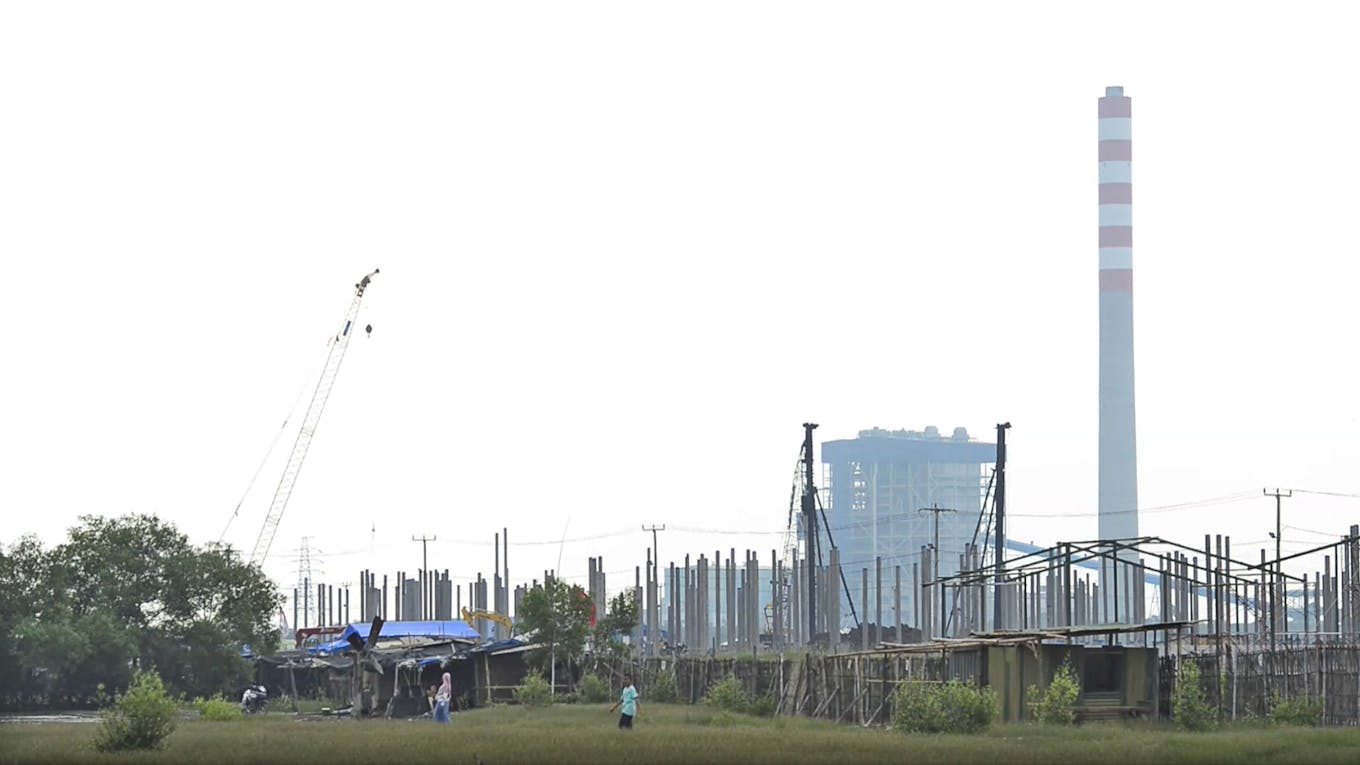
WALHI, or the Friends of the Earth Indonesia, has documented that about 3,000 farmers and fisherfolk in the village of Kanci and some five neighbouring coastal towns have had their livelihoods disrupted by the power station. Image: ResponsiBank Indonesia
These sentiments are echoed by Hassan of the Forum: “After decades of bankrolling coal power projects in the region, the ADB committed to stop financing new coal power projects in 2021.”
Yet, the ADB consistently fails to meaningfully address the demands for justice and accountability raised by communities whose health and livelihoods have been ravaged by the ADB’s investments in coal-related infrastructure, including in Mongolia, Pakistan and the Philippines.
ADB plans to pilot similar “coal-to-clean” ETM in Pakistan, the Philippines, and later in Kazakhstan and Vietnam.
To keep in step with the Paris Agreement, the United Nations Economic and Social Commission for Asia and the Pacific has urged that phasing out coal by 2040 is “the single most important step” that governments need to pledge. Given the urgency of shutting out coal, ADB’s ETM may be insufficient as a “coal-to-clean” initiative.
“A just energy transition is not as simple as shifting from fossil fuels to less carbon-intensive sources of energy,” said Bernadette Victorio, program lead, Fair Finance Asia.
“The ‘just’ element must be reflected in the quality and pace at which the transition happens. Are the rights of communities, workers, and indigenous peoples respected and safeguarded? Are there broad, inclusive, democratic, and transparent consultative processes happening between key stakeholders? Are we ensuring that this whole process is not lopsidedly benefitting fossil fuel companies and their investors?”
The Asian Development Bank has responded to the criticisms made against it. Read its replies here.



